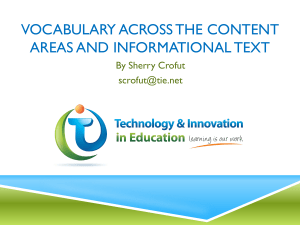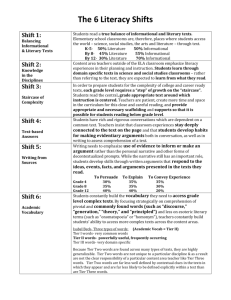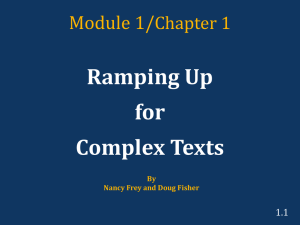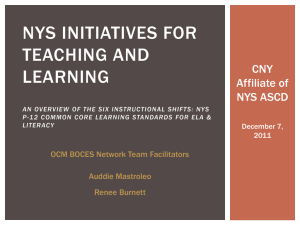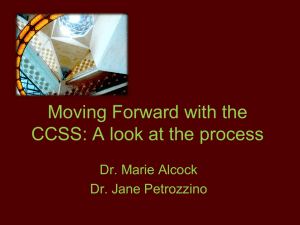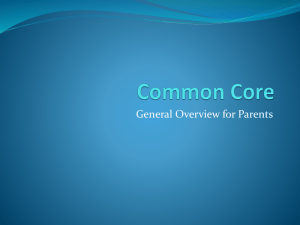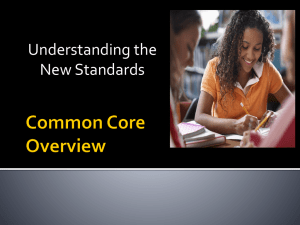Vocabulary and Informational Text - scrofut
advertisement
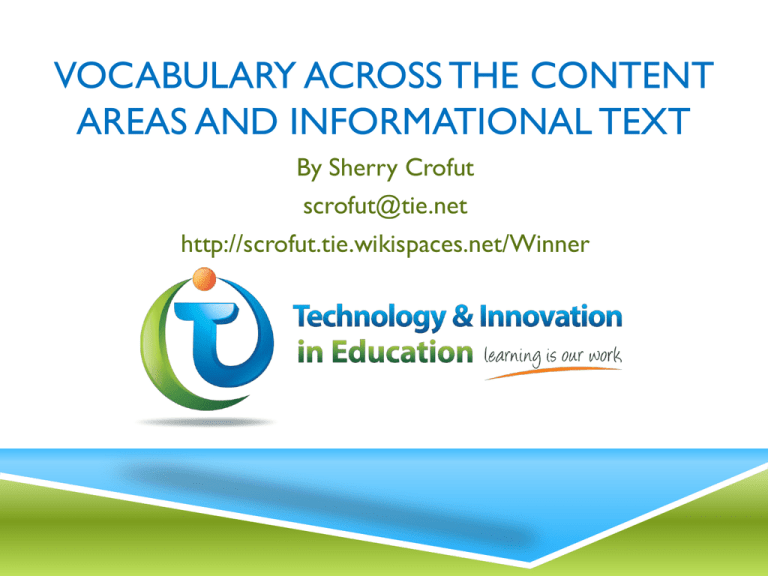
VOCABULARY ACROSS THE CONTENT AREAS AND INFORMATIONAL TEXT By Sherry Crofut scrofut@tie.net http://scrofut.tie.wikispaces.net/Winner OUR GOALS Become familiar with the CCSS Informational Text Reading Standards in the content areas Identify how the English Language Arts Common Core Standards address vocabulary Look at context clue instruction Become familiar with the concept of academic vocabulary (Tier 2 words) and why they are important to teach Explore strategies and resources for teaching vocabulary Shift 1 Balancing Informational & Literary Text Students read a true balance of informational and literary texts. Shift 2 Knowledge in the Disciplines Students build knowledge about the world (domains/ content areas) through TEXT rather than the teacher or activities Shift 3 Staircase of Complexity Students read the central, grade appropriate text around which instruction is centered. Teachers are patient, create more time and space and support in the curriculum for close reading. Shift 4 Text-based Answers Students engage in rich and rigorous evidence based conversations about text. Shift 5 Writing from Sources Writing emphasizes use of evidence from sources to inform or make an argument. Shift 6 Academic Vocabulary Students constantly build the transferable vocabulary they need to access grade level complex texts. This can be done effectively by spiraling like content in increasingly complex texts. LITERACY STANDARDS IN THE CONTENT AREAS Augment rather than replace content standards in social studies and science; Include exemplars of text complexity at specific grade bands, but do not specify required texts; Build toward students being able to learn disciplinary content through reading; and Are “back-mapped” from the College and Career Readiness Anchor Standards, which reflect the requirement that students exiting high school be able to read a high volume of challenging informational text independently. NAEP The Standards follow NAEP’S lead in balancing the reading of literature with informational texts, including texts in history/social studies, science, and technical subjects. WHY MORE INFORMATIONAL TEXT? Provides an ideal context for building language, vocabulary, knowledge, and reasoning Is challenging and complex and has deep comprehension-building potential Is an opportunity for students to learn how to engage, interact, and have “conversations” with the text in ways that prepare them for the type of experiences they will encounter in college and careers ELA COMMON CORE VOCABULARY STANDARDS Reading Strand Reading Anchor Standard #4 Interpret words and phrases as they are used in a text, including determining technical, connotative, and figurative meanings, analyze how specific word choices shape meaning or tone. Language Strand Language Anchor Standard #4 Determine or clarify the meaning of unknown and multiple-meaning words and phrases by using context clues, analyzing meaningful word parts, and consulting general and specialized reference materials as appropriate. Language Anchor Standard #6 Acquire and use accurately a range of general academic and domain-specific words and phrases sufficient for reading, writing, speaking, and listening at the college and career readiness level; demonstrate independence in gathering vocabulary knowledge when encountering an unknown term important to comprehension or expression. AB PYRAMID High 5’s until the music stops Grab a partner and two chairs One chair faces forward and the other faces backwards, hip to hip This will be like the $25,000 Pyramid Give clues – when you have all the words, stand up and shout I’VE GOT IT!!! Arrange Collaborate Create Decide Define Elaborate Execute Hypothesize Measure Problem Solve Reference Seek Information Symbolize Think Metacognitively Transform Evaluate RESEARCH BEHIND VOCABULARY INSTRUCTION Effective vocabulary instruction has to start early, in preschool, and continue throughout the school years (Nagy, 2005). Teaching vocabulary helps develop phonological awareness (Nagy, 2005) and reading comprehension (Beck, Perfetti, & McKeown, 1982). Vocabulary instruction needs to be long-term and comprehensive (Nagy, 2005) for ELLs (Carlo, August, & Snow, 2005; Calderón et al., 2005). MORE RESEARCH…. Command of a large vocabulary frequently sets high-achieving students apart from less successful ones (Montgomery, 2000). The average 6-year-old has a vocabulary of approximately 8000 words, and learns 3000-5000 more per year (Senechal & Cornell, 1993). Vocabulary in kindergarten and first grade is a significant predictor of reading comprehension in the middle and secondary grades (Cunningham, 2005; Cunningham & Stanovich, 1997; Chall & Dale, 1995; Denton et al. 2011). CONTEXT CLUE STEPS CONTEXT CLUE STEPS For Students For Teachers 1. Identify the unknown word. 2. Look for the words that give hints about its meaning in the sentence. 3. If you need more cues, read the sentences before and after the one with the word in it. 4. Infer the word’s meaning based on what you found. Then model it… “As Tom stepped out of the tent, the moist grass soaked his shoes and he wondered if it had rained.” Say aloud… “The grass is moist. It soaks Tom’s shoes. Tom thinks it rained. Rain makes things wet. Moist must mean…..” “Now try ‘wet’ in place of moist to see if it makes sense.” Adapted from Vocabulary Instruction Module developed for Reading Excellence Act. Graves (2002) ACADEMIC VOCABULARY Isabel L. Beck, Margaret McKeown and Linda Kucan (2002, 2008) have outlined a useful model for conceptualizing categories of words readers encounter in texts and for understanding the instructional and learning challenges that words in each category present. They describe three levels, or tiers, of words in terms of the words’ commonality (more or less frequently occurring) and applicability (broader to narrower). Common Core State Standards, Appendix A, page 33 ACADEMIC VOCABULARY … is not unique to a particular discipline and as a result are not the clear responsibility of a particular content area teacher.What is more, many Tier Two words are far less well defined by contextual clues in the texts in which they appear and are far less likely to be defined explicitly within a text than are Tier Three words.Yet Tier Two words are frequently encountered in complex written texts and are particularly powerful because of their wide applicability to many sorts of reading.Teachers thus need to be alert to the presence of Tier Two words and determine which ones need careful attention. Common Core State Standards (English Language Arts, Appendix A) 3 TIERS OF WORDS – Highly specialized, subject-specific; low occurrences in texts; lacking generalization ◦ E.g., lava, aorta, legislature, circumference –Abstract, general academic (across content areas); encountered in written language; high utility across instructional areas ◦ E.g., vary, relative, innovation, accumulate, surface, layer – Basic, concrete, encountered in conversation/ oral vocabulary; words most student will know at a particular grade level ◦ E.g., clock, baby, Common Core State Standards, Appendix A, page 33 WHY ARE “ACADEMIC WORDS” IMPORTANT? They are critical to understanding academic texts. They appear in all sorts of texts. They require deliberate effort to learn, unlike Tier 1 words. They are far more likely to appear in written texts than in speech. They often represent subtle or precise ways to say otherwise relatively simple things. They are seldom heavily scaffolded by authors or teachers, unlike Tier 3 words. Common Core State Standards, Appendix A, page 33 EIGHT RESEARCH-BASED CHARACTERISTICS OF EFFECTIVE VOCABULARY INSTRUCTION 1. Effective vocabulary instruction does not rely on definitions. 2. Students must represent their knowledge of words in linguistic and nonlinguistic ways. 3. Effective vocabulary instruction involves the gradual shaping of word meanings through multiple exposures. 4. Teaching word parts enhances students’ understanding of terms. 5. Different types of words require different types of instruction. 6. Students should discuss the terms they are learning. 7. Students should play with words. 8. Instruction should focus on terms that have a high probability of enhancing academic success. (Adapted from Building Academic Vocabulary by Robert Marzano and Debra Pickering, 2005) A SIX-STEP PROCESS FOR TEACHING NEW TERMS Step 1: Provide a description, explanation, or example of the new term. Step 2: Ask students to restate the description, explanation, or example in their own words. Step 3: Ask students to construct a picture, symbol, or graphic representing the term or phrase. A SIX-STEP PROCESS FOR TEACHING NEW TERMS Step 4: Engage students periodically in activities that help them add to their knowledge of the terms in their notebooks. Step 5: Periodically ask students to discuss the terms with one another. Step 6: Involve students periodically in games that allow them to play with terms. Adapted from Building Academic Vocabulary by Robert Marzano and Debra Pickering, 2005 HOW MANY WORDS? In school settings, students can be explicitly taught a deep understanding of about 300 words each year. Divided by the range of content students need to know (e.g., math, science, history, literature), of these 300–350 words, roughly 60 words can be taught within one subject area each year. It is reasonable to teach thoroughly about eight to ten words per week. (Chall, 1996) IMPLICATIONS FOR INSTRUCTION Teach fewer words. Focus on important Tier 2 (high utility, cross- domain words) to know & remember. Simply provide Tier 3 (domain-specific, technical) words with a definition. VOCABULARY WEBSITES http://www.wordsift.com/ Word maps, word clouds http://quizlet.com/ Make flash cards & games http://jc-schools.net/tutorials/vocab/ Academic vocabulary games http://www.vocabulary.com/ More games, including games using Latin & Greek roots www.worldwidewords.com Definitions, history and short essays on words http://www.visualthesaurus.com/ Visual thesaurus www.vocabgrabber.com www.wordle.com ONLINE RESOURCES FOR GAMES… http://www.vocabulary.co.il/ http://www.freereading.net/index.php?title=Vocabulary_Rein troduce_and_Build_Mastery_Activities http://www.visuwords.com/ http://www.pppst.com/templates.html http://jc-schools.net/tutorials/gameboard.htm http://its.leesummit.k12.mo.us/gameresources.htm http://people.uncw.edu/ertzbergerj/ppt_games.html http://reading.pppst.com/vocabulary.html

